Starting an online store to sell products and services is easier than ever with plug-and-play ecommerce platforms and web builders. First, you’ll need to iron out a business concept and choose products to sell. Then, select a software platform, build your website, and choose an order fulfillment strategy. Online stores are visual platforms, so you’ll need to have a strong marketing plan. Overall, plan to spend around $100 to set up your online store (not including products).
Table of Contents:
Here’s how to start an online store in seven steps:
1. Choose a Business Concept
Building an online store starts with honing the idea for the products you would like to sell. When choosing what to sell, first select an overall concept by figuring out which niche or industry you would like to focus on. This idea can come from personal interests or market opportunities.
For example, a dog enthusiast might open an online store with pet products. However, someone looking to fill a market void might look to fill a need such as organic dog food specifically for pit bulls. It’s much easier to target customers with a specific interest and sell products that directly appeal to them, rather than offering a wide array of general merchandise. Choosing a niche will also give you a specific direction to start with and makes it easier to develop a strong brand.
Once you have a general concept, decide on a business model. For ecommerce websites, this generally means how you will source products, price items, and fulfill orders. You’ll also need to design your brand, including a name and logo.

Pop Your Pup is a niche ecommerce site that creates custom products using customer’s pet photos
Select a Business Model
Once you have an idea of what you want to sell, you need to decide how you want to sell it. Some business models include:
- Start a drop shipping business and not stock inventory
- Develop and manufacture your own custom products
- Start a private label brand
- Pack and ship orders yourself
- Use a third-party to store inventory and fulfill orders
Start by thinking realistically about the amount of time you want to invest in your ecommerce venture. How much space do you have available or are willing to obtain for storing inventory? If your online store is a side project, it may be realistic only to sell and stock a few products. Or, only sell products that are available for drop shipping, so you don’t have to fulfill orders or pay for a third-party service.
However, if you are looking to grow your online business, you will likely want to develop custom or private label products and stock many of them yourself. This plan means having a dedicated garage, room, or storage space for managing inventory and packing orders.
Design a Brand
Once you have an idea of what you want to sell and how you want to sell it, you’ll need to develop a brand. This process includes picking a company name, website, and logo. Do this early in the process of building an online store because you will need to purchase a domain name. Your domain name should either be your brand name or at least contain your brand name. For example, Away luggage brand’s website is awaytravel.com (away.com is already taken).
When choosing a domain name for your online store, be sure to:
- Choose a name ending in “.com”
- Make sure it is easy to spell
- Keep it as short as possible
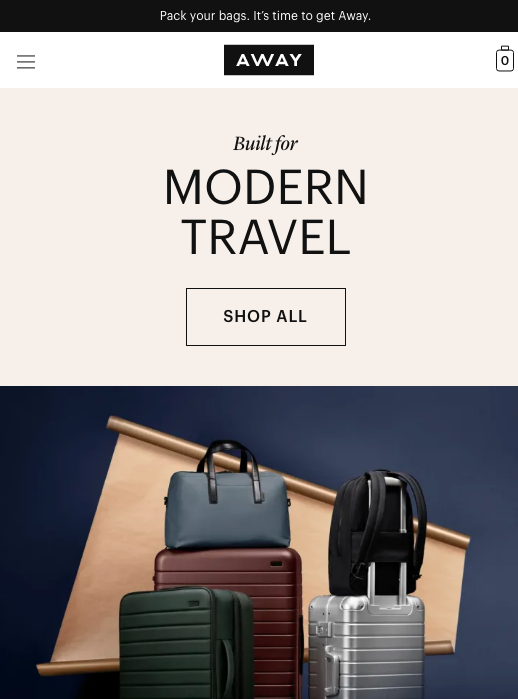
The domain away.com was already taken, so Away luggage used awaytravel.com
Apply for Licenses and Trademarks
It’s a good time to outline what licenses and legal protections you will need to start your business. Anyone selling products will need to obtain a resale license, also known as a reseller’s permit or sales tax ID from your state’s tax department. You will need to apply for this in each state where you have a physical presence (such as a warehouse).
If you are manufacturing or designing products, you will also want to file for a patent with the United States Patent and Trademark Office (USPTO) if your products qualify. You will also want to trademark your business name to prevent others from selling under your brand name.
2. Source Your Products
Once your plan is solid, the next step is actually sourcing your products. It will take some time to find the right suppliers and make sure you are satisfied with the final results. Plan to spend several months and several thousand dollars requesting sample orders from different suppliers, especially if you are customizing your products in any way with a unique formula, design, or branding.
How to Find Suppliers
Arguably the hardest part of starting an online store is finding a supplier you trust to deliver quality products on time and for the right price. There are a few different ways new businesses can go about finding one that is best for them. You can start by researching what manufacturers your competitors are using. You can also request samples from many suppliers at once through Alibaba or other US-based wholesale directories. The most traditional option is to visit industry trade shows to connect with suppliers in person.
Research Your Competitors
To find a supplier, one of the first steps you can take is to research your competitors. Purchase a few of their products and research what is on the product label. Many of them will have the manufacturing location, or other details, which you can use in a Google search. There are also smartphone apps you can download that will scan product bar codes and pull up details on the manufacturer. With your smartphone and these apps, you can gather a lot of manufacturing leads on a trip to the mall, box store, or boutique.
Connect With Manufacturers Through Alibaba
Alibaba has millions of products from thousands of manufacturers. Through Alibaba, you can find suppliers to manufacture products, build private labels, or purchase ready-made products to resell. The site is a top name in product sourcing and makes it easy to search for specific products and filter results by price, minimum order, or browse top-ranking suppliers. You can even search by image if you have a product you want to replicate.
 Tip: Manufacturing your own products can result in the most profits. The downsides of manufacturing custom products are that it requires a lot of upfront cash and large order quantities, which also means a bigger risk.
Tip: Manufacturing your own products can result in the most profits. The downsides of manufacturing custom products are that it requires a lot of upfront cash and large order quantities, which also means a bigger risk.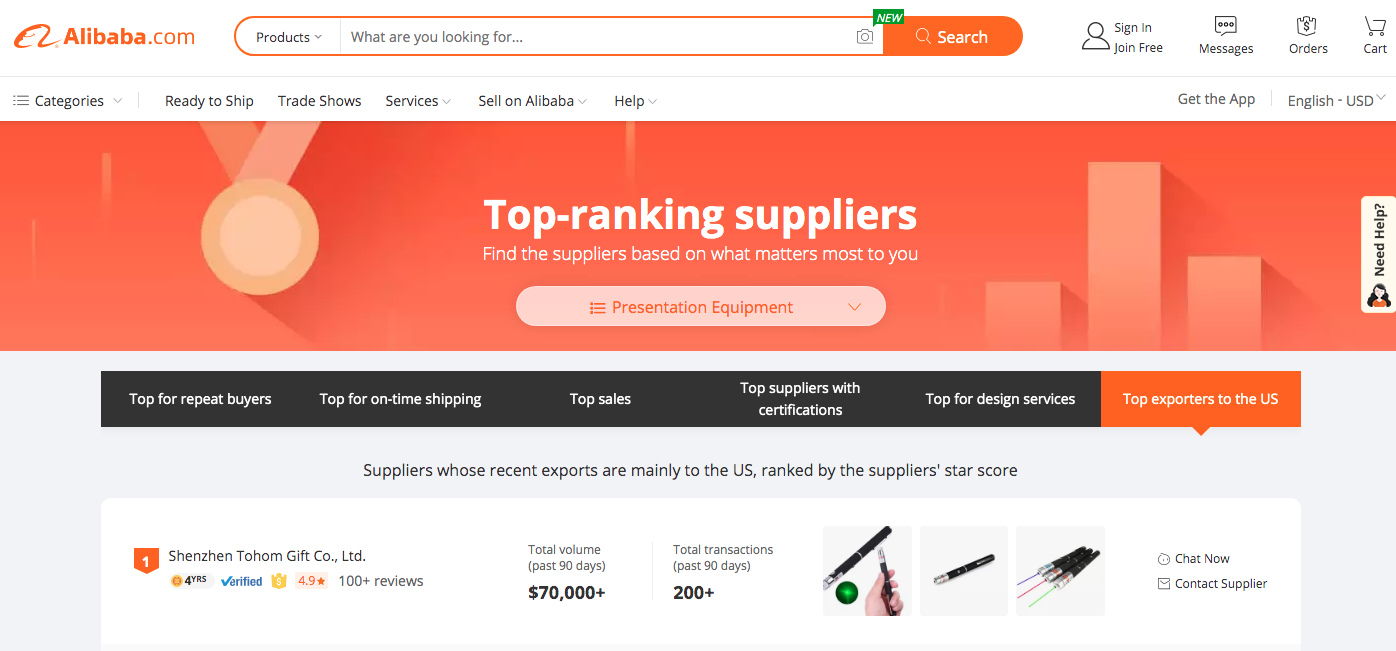
Businesses can browse top-ranking suppliers on Alibaba
Use a Directory Service to Find US-based Suppliers
In addition to searching Alibaba, there are several other directory sites offering mostly ready-made products. Some directory sites link to outside suppliers, while others have a built-in interface for placing orders.
Popular wholesale sites include:
- Faire: Unique items from smaller apparel, gift, beauty, and home product makers.
- The Grommet Wholesale: Unusual gift items from independent makers and manufacturers.
- Worldwide Brands: A directory site with thousands of wholesale suppliers.
- Wholesale Central: A free directory site with thousands of wholesale suppliers.
Attend Trade Shows and Wholesale Marketplaces
Attending trade shows is the most efficient way to test a lot of products firsthand and is a great way to find suppliers you might not otherwise encounter, especially if you are only searching online. There are some permanent showrooms that you can visit year-round to find suppliers and products. Other shows are temporary and bring in thousands of vendors at once.
Some of the most popular trade shows include:
- AmericasMart Atlanta: Gift and home items.
- NY NOW: Gift, lifestyle, handmade, and home items.
- Toy Fair: Toy, collectible, and children’s products.
- Cosmoprof North America: Skincare and beauty products, including private label.
- ASD Market Week: General merchandise, apparel, accessories, and suppliers offering custom and private label.
- MAGIC: One of the largest apparel and accessory shows.
Consider Designing a Private Label Brand
Private label brands are goods manufactured by one company but then sold under the retailer’s brand name. Private label products help businesses build a strong identity, and help prevent your customers from trying to find your products for lower prices on other online stores. To start a private label brand, design a logo and packaging to place on a standard or slightly customized product from a manufacturer or wholesaler.
Starting a private label brand is a good middle-ground option between manufacturing a custom product and buying traditional wholesale goods. Private label items provide unique branding, SKUs for product listings, and sometimes unique formulas or design elements. Still, the process is much easier than designing and manufacturing a completely new product.
3. Choose an Ecommerce Platform
Some ecommerce platforms offer templates with easy add-on features and adjusted via drag and drop. There are other platforms with greater flexibility for those who want to add their own coding elements. There are also shopping cart plugins that can be added onto existing websites for businesses looking to monetize their site by selling products.
Creating a Templated Store vs Designing From Scratch
When building an online store, the first decision to make before selecting a platform is whether to use a templated store design or build a site from scratch. There are advantages and disadvantages to each. Larger businesses with developers on-hand may benefit from a custom store. However, most small businesses that don’t have a developer on-hand and want to be able to manage the website themselves would have the flexibility to do so with a templated design.
Popular Ecommerce Platforms
There are several popular ecommerce platforms that many small businesses use to learn how to build an online store. Shopify, BigCommerce, and Square Online Store are some of the most popular platforms for new businesses and retailers looking to expand online. All of these programs offer templates, varying levels of inventory management tools, reporting, and options for connected payment processing.
These tools also offer native or plug-in solutions for selling and advertising on social media, selling in-person, connecting a blog, and selling on third-party marketplaces like Amazon and eBay. They also have different plans for businesses of different sizes and sales volumes.
- Shopify: Best overall ecommerce platform for small businesses.
- BigCommerce: Best ecommerce platform for growing businesses.
- Square Online Store: Best online store builder for small stores and cafes.
- Weebly: Best drag-and-drop builder for online stores.
When to Use a WordPress Site
If your business is not a dedicated ecommerce site, but a blog, coaching, or publishing site that also sells merchandise, you may want to create a WordPress site and add a WooCommerce or other WordPress shopping cart plugin. Businesses can also turn any existing WordPress site into an ecommerce store by using these plugins, so it is a good option for businesses looking to sell merch or expand into retail sales.
4. Build Your Ecommerce Website
After choosing a platform, the next step is building your online store’s website by selecting a theme, incorporating payment processing, putting security measures in place, and getting any necessary add-ons. Refer back to your brand design and any custom products or packaging you have for a guide on choosing a color scheme, fonts, and an overall look for your site.
Choose a Theme
No matter what ecommerce platform you choose, all of them have many options for free and paid templates or themes, usually with multiple variations available. There are also many free and paid WordPress ecommerce themes available for different shopping cart plugins.
When choosing a theme for your online store:
- Invest in quality: Don’t shy away from paid themes, spring for the one you think is best; it’s not impossible to change themes later, but it is easier to pick the right one from the start.
- Opt for a responsive theme: Mobile browsing makes up a large portion of online shopping, so make sure your theme is optimized for mobile.
- Prioritize navigation features: Easy navigation is critical for a positive user experience, so make sure your theme has a great header, search, and related product navigation features.
- Evaluate product pages: Quality product pages help increase conversions; choose themes with options for lots of high-quality photos and/or images, multiple types of product descriptions, and other dynamic content.
Integrate Payment Processing
Integrating payment processing is a mundane yet critical element of building an ecommerce website. As an online retailer, you’ll need to choose a Payment Card Industry (PCI) compliant payment processor. Many ecommerce platforms have built-in payment processors or a few select payment partners that are compatible. Any built-in payment processors will be PCI compliant. For example, Square, Shopify Payments, Stripe, and PayPal are all PCI compliant.
For most small businesses, opting for the built-in payment processor is the easiest option. Payment processing rates between ecommerce platforms are usually competitive. However, once you start to grow larger (processing more than $15,000 per month) it may be worthwhile to actively shop for a payment processor that can offer lower rates, or negotiate a lower rate with your existing processor as you could qualify for volume discounts.
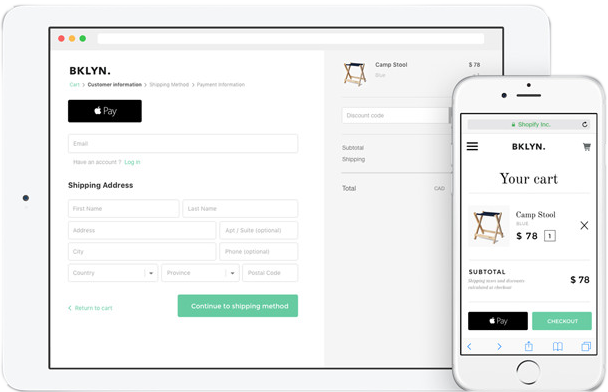
Shopify has options for standard checkouts, Apple Pay, PayPal, plus installment payments through third-party plugins
Adding Alternative Payment Methods
As an online seller, it’s critical to have an option for shoppers to enter their credit or debit card information. However, having more user-friendly options like one-click and eWallet payments, PayPal, and installment options are important for increasing conversions and sales. Most major ecommerce platforms have a direct integration for accepting PayPal payments. Many also accept Apple and Google wallet payments.
Installment payments are typically offered by a third-party processor that pays the retailer upfront but collects monthly payments from customers, so shoppers are only paying a fraction of the total cost upfront. Many of these services don’t charge customers interest or require hard credit checks. These payment options are appealing for shoppers that don’t use traditional credit cards. Popular providers include AfterPay, Klarna, Splitit, and PayPal Credit.
5. Decide How You’ll Fulfill Orders
Order fulfillment is the process of storing products, packing customer orders, and shipping products out to customers. When first starting out, many small businesses handle this process themselves out of a garage or storage space. However, some companies handle order fulfillment for ecommerce sellers.
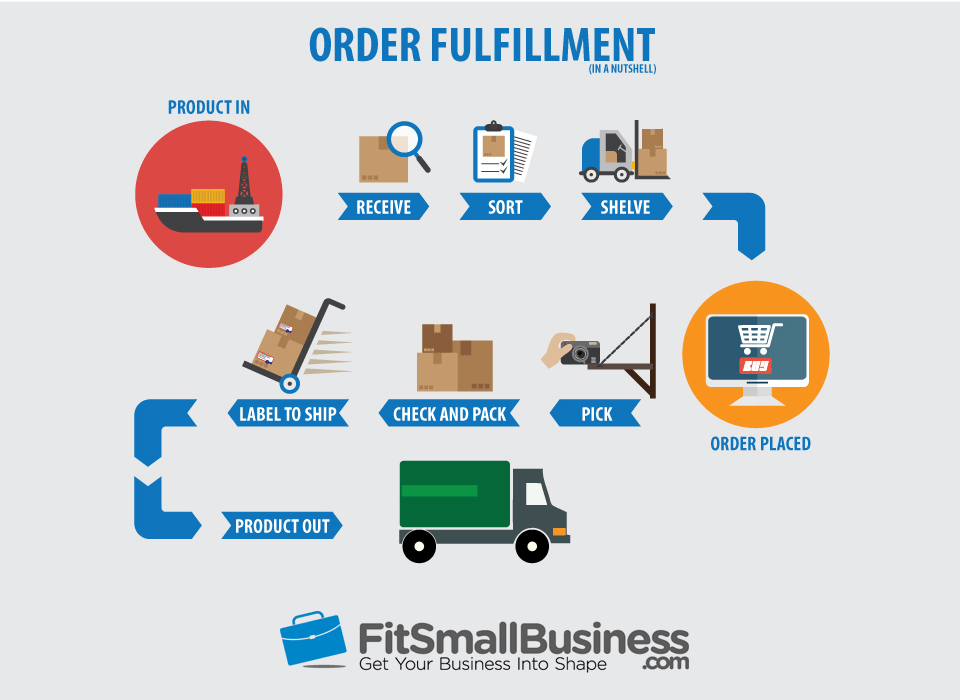
Some order fulfillment companies will store products for you and pack and send customer orders as they come in. With this method, ecommerce businesses still purchase inventory upfront and send it to the order fulfillment company to store. This method is often best for ecommerce businesses that have outgrown their at-home fulfillment space and do not want to start their own warehouse and large-scale fulfillment operation.
However, there are also drop shipping companies. Drop shipping companies serve as the product supplier and fulfill customer orders, so ecommerce businesses don’t have to purchase inventory upfront. When working with drop shipping companies, ecommerce sellers are limited in that they can only sell products the drop shipper has available. However, there are fewer upfront costs and a lot less work involved for ecommerce businesses.
Select a Shipping Provider
If you are packing and shipping customer orders in-house, you’ll also need to choose a shipping company. Most ecommerce platforms like Shopify, BigCommerce, and Square Online Store have built-in shipping tools. These platforms have discounted shipping rates, automatically calculate shipping costs for customers at checkout, and make it easy for ecommerce businesses to print shipping labels directly from the order management system.
However, if you built your own site, or are using a shopping cart plugin that does not have these features, you’ll need to find a third-party solution. For small operations, Stamps.com is a popular option. It syncs with many online marketplaces like Amazon and Etsy, plus shopping carts like Magento. Simply import customer orders and print out the shipping labels at home.
6. Add Detailed Product Pages
When the infrastructure of your online store is in place, it’s time to add in the actual products. There are multiple layers to this process. First, you’ll need to enter in all of the inventory data for each item like wholesale price, retail markup, vendor information, SKUs and barcode information, categories, colors, sizes, quantities, and whatever other data points are relevant for your specific merchandise. If you already have a list of inventory, you can upload this information in bulk via CSV or Excel file. Otherwise, you can manually enter each product.
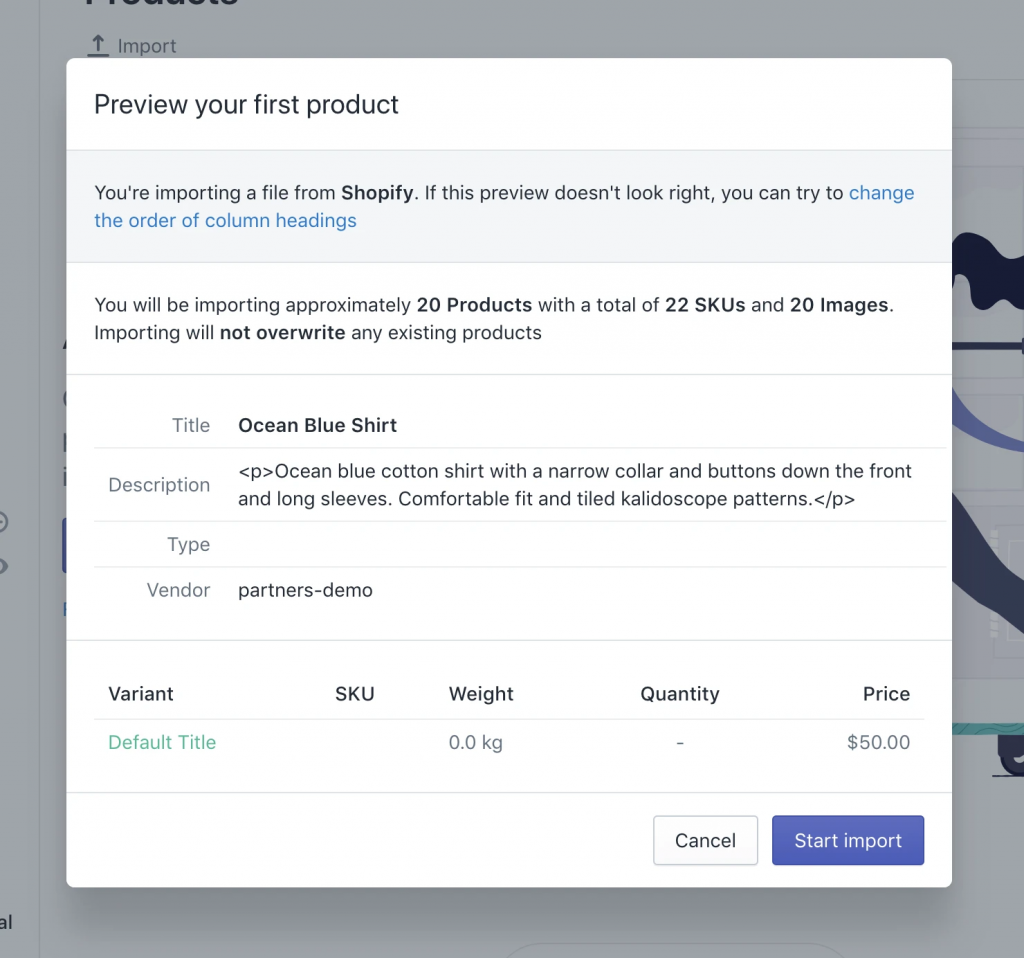
Most ecommerce platforms, including Shopify, let businesses upload products in bulk with CSV files
Create Descriptive Product Pages
After you enter the data, the next step is creating a detailed individual product page for each item. For ecommerce websites, product pages are arguably the most important element of the site. Shoppers can land on a product page after browsing your store, from a Google search, or via a targeted advertisement.
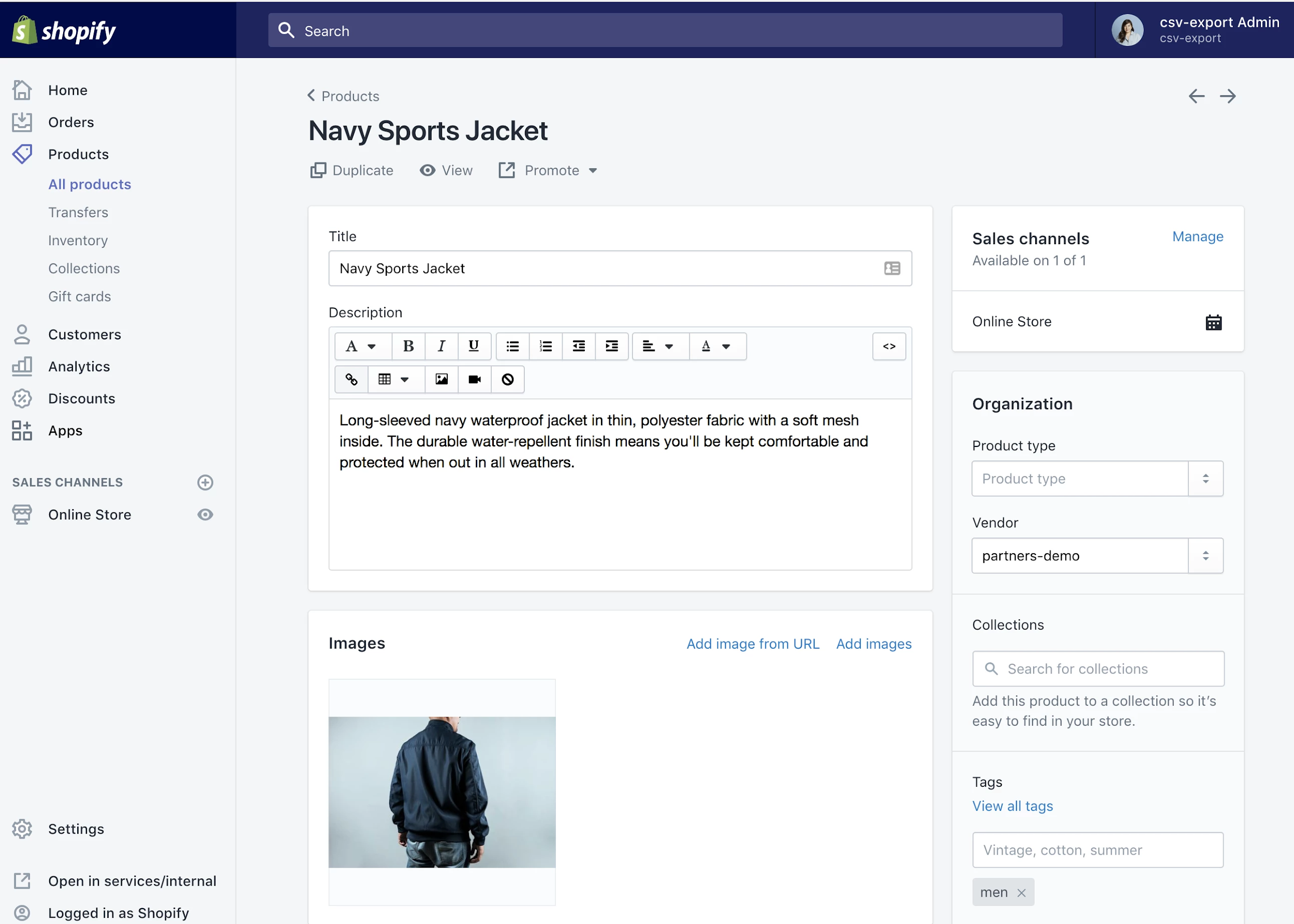
In Shopify, sellers can add specific details to each product page and listing
A product page should have:
- Clear pricing information: Pricing should be displayed prominently and clearly indicate whether or not the price displayed is before or after any promotions.
- Easy “Add to Cart” buttons: Add a large “Add to Cart” button next to product images and below pricing information; the goal is to get shoppers to buy, so make sure the button is a color that stands out.
- High-quality photos: Product photos can make or break sales. Use high-quality images that show products from all angles, in all variants, and in action where situationally relevant.
- Customer reviews or social proof: When buying online, shoppers can’t see or feel the product for themselves, so they rely on customer reviews to assess product quality. Incorporate user reviews in product pages and/or photos and testimonials from social media—most ecommerce platforms have these features built-in or available through a plug-in.
- Helpful product descriptions: Product descriptions should be concise and include precise product information like size and material, but should not be salesy.
- Proactively address customer concerns: Indicate whether or not shipping is free or calculated at checkout, or if there is a minimum order for free shipping.
- Show related products: At the bottom, display similar products, or items people who bought the item also purchased—some ecommerce platforms have this built-in, others have this feature available through plug-ins.
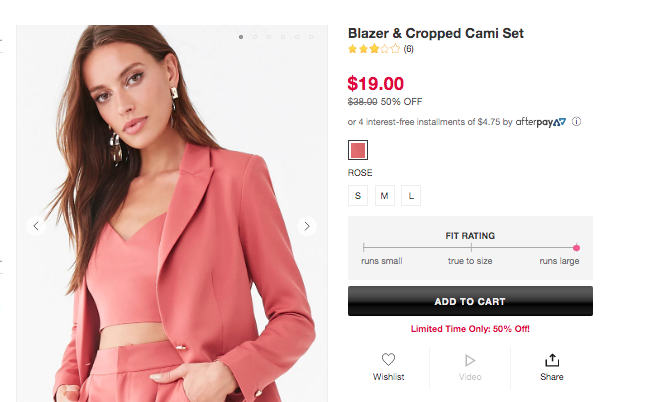
Forever 21 indicates a limited-time sale and displays a fit rating on its product page
Write Well-crafted Product Descriptions
Product descriptions should be uniform across the site, following the same template and tone throughout. In general, there should be three elements to a product description: a short intro, bullet points outlining high-level features, and a longer description at the bottom for shoppers who want greater detail.
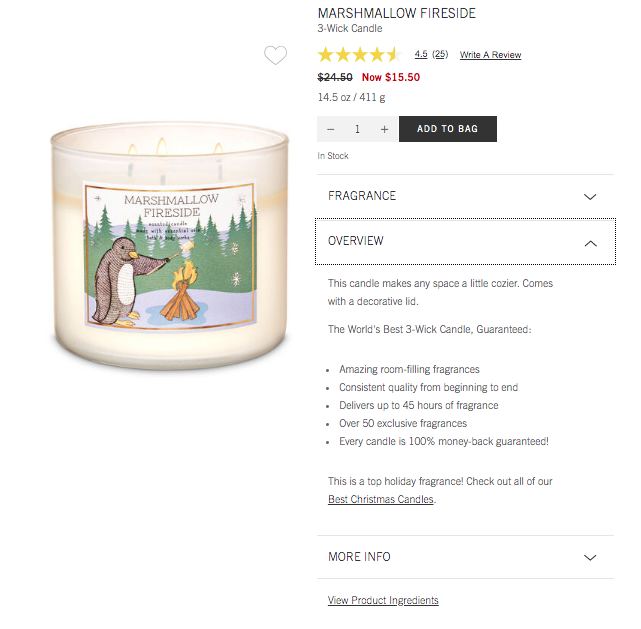
Bath & Body Works product pages have collapsible sections describing the fragrance, features, safety, and instructions for each product
Upload High-Quality Product Photos
Product photos are one of the most important elements of an online store. High-quality images can showcase the details and quality of an item, while low-quality or grainy photos leave shoppers with more questions than answers.
Some wholesale suppliers will provide high-quality photos of their products, which will save you a lot of time and money. Ask your suppliers if this is something they provide. If not, you can either take the photos yourself or hire a professional.
When taking the photos yourself, use a plain white background in a well-lit area. You can do product photography on a budget with a smartphone camera and natural light. Though, if you are not a professional or experienced photographer, for the best (and fastest) results, there are services that specialize in ecommerce photography.
Square Photo Studio offers very affordable product photography with a fast turnaround time. Ship Square the products, choose three photos with different angles for $9.95 or a 360-degree photo for $29.95. Square will send you the images within 14 days.
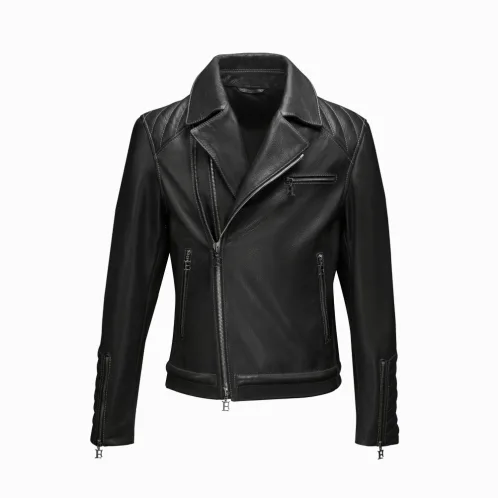
Square Photo Studio delivers product photos with a white background and apparel displayed on a ghost mannequin
In addition to standalone product shots and 360-degree photos, also consider photos of the product in-use. This is especially important for apparel, accessories, and makeup items. Shoppers will want an idea of what the product will look like on them. For decor and home items, consider lifestyle photos of the products so customers can picture the items in their own homes.
7. Launch and Market Your Online Store
After setting up the product pages, your site is ready to launch. Once your online store is live, it will require a multi-pronged marketing approach with search engine optimization (SEO), listings on additional sales channels, and email marketing to bring in a steady flow of shoppers. Some ecommerce businesses also use in-person sales at pop-ups and events to grow their business.
Create an SEO Strategy
Online stores need at least a basic SEO strategy to make sure that product pages appear in search results. To do this, ecommerce sellers need to target a keyword with each individual product page (such as “striped polyester T-shirt”). Ecommerce websites should also make sure to add product titles and descriptions that will appear in search engine results and alt text for images.
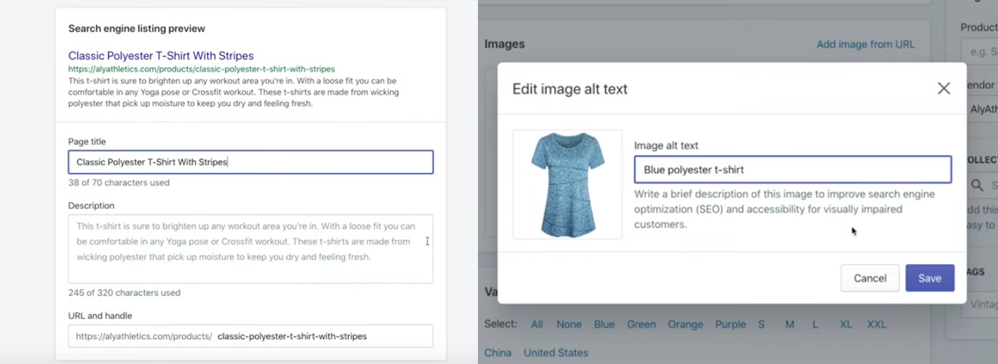
Shopify has tools to help ecommerce businesses set page titles, descriptions, and image alt text to make pages optimized for Google
Online store builders like Shopify and BigCommerce have built-in tools to make this process easy. In addition to optimizing individual pages, ecommerce businesses should have a logical and user-friendly site structure so shoppers can easily navigate the website.
Sell on Marketplaces
Many successful ecommerce businesses grow by selling their products in more than one place. Even with a standalone store, many online businesses also sell on Amazon, eBay, Walmart, and Etsy. These sales likely won’t drive traffic to your main store, but they are a good way to bring in revenue and can help strengthen your brand credibility and recognition.
Shopify, BigCommerce, and most ecommerce platforms have tools to sell on Amazon, so your inventory and customer order information is synced and centralized in one place. This means you won’t have to check several places for customer orders, or manually update available products across multiple sites.
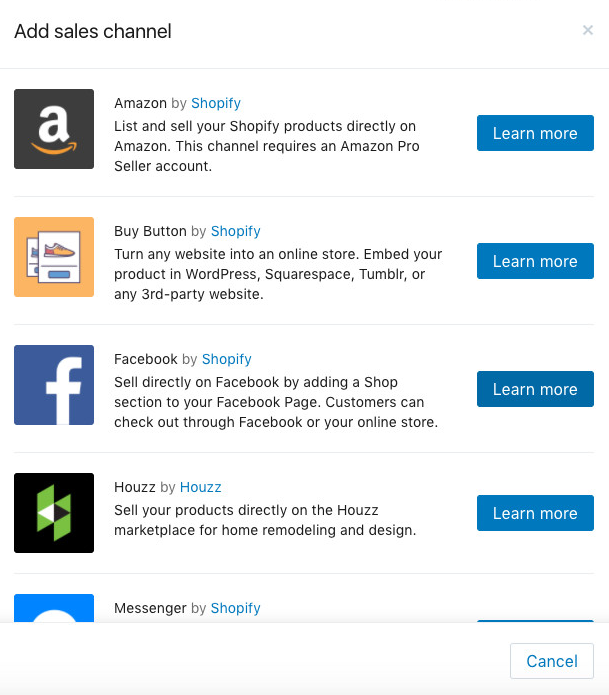
Shopify lets ecommerce businesses sell directly on other popular sales channels
Sell on Facebook and Instagram
For new online brands, advertising and selling on Instagram and Facebook are popular ways of gaining recognition. Both social platforms let businesses create advertisements directly linking to product pages, or with options to buy without even leaving the social site. Plus, businesses can create ads targeting customers in a specific area, with particular interests, or of a certain age group.
Grow Your Email List
Email promotions are one of the best tools an online store has for driving repeat sales and connecting with customers. Ask customers to provide their email addresses with orders, but also have a sign-up option for people who visit your site but do not make a purchase. Most ecommerce platforms have either built-in tools for email marketing or integrations with email marketing solutions like Mailchimp.
Frequently Asked Questions About Starting an Online Store
Starting an online store looks a little bit different for everyone depending on the type of business you have, and whether you’re taking a storefront online or building a new company from scratch. Here are some of the most common questions around starting an online store.
How do I start an online store with no money?
Square Online Store has a forever-free option that allows you to build a multi-page online store. Once you gain traction, you can upgrade your plan for more advanced features. However, expect to put in a lot of work and time before your store becomes significantly profitable.
Do I need a business license to start an online store?
Whether you’re a brick-and-mortar storefront or an online store, most states will require a business license. This is so that you may collect taxes from your customers, and the IRS may track tax revenue. Your state’s department of revenue should have the info you need.
How much money can I make with an online store?
While there are no guarantees you’ll make any money, you may make a profit with the right resources. Whether you’re covering the costs of your monthly hosting or making a full-time income, any of it is possible given time, talent, and resources. Your income depends on your niche, audience, and expenses.
How can I grow my online store?
- Blogging: Gain fans by showcasing your expertise in your niche.
- Pinterest: You can create shoppable pins and even share blog posts on Pinterest.
- Email marketing: Market to an email list by collecting emails.
- Video marketing: Creating videos can help your potential customers see your product in action.
- Coupon promotions: Send coupons through email marketing or social media ads.
- Free shipping offers: Offering free shipping can help increase sales.
- Influencer marketing: Hiring an influencer in exchange for compensation, whether product or cash, can help bring in sales.
- Paid social media ads: If you have the budget, you can focus efforts on paid marketing like Facebook ads and Google Ads. These let you drive targeted traffic to your site or certain products. When you make a sale, be sure to use other tactics, like promotional inserts in shipments, to keep customers coming back.
If you’re creative and persistent, you can attract a following with blogging, social marketing, email, video, and offline engagement, and spend very little money doing it.
Bottom Line – How to Start an Online Store
Thanks to plug-and-play software like Shopify, BigCommerce, and Square Online Store, learning how to set up an online store is easy. Most people can even set up a basic store in under a day. However, building a successful and profitable ecommerce operation requires much more than simply building an ecommerce site. You’ll need a business plan, carefully selected or manufactured products, a marketing strategy, and an organized order fulfillment operation.
Shopify is one of the biggest names in ecommerce software because it makes it easy for individuals or businesses of any size to start an online store. Preset templates and built-in inventory and order management features make it simple to get an ecommerce business up and running in no time. Shopify’s app marketplace offers drop shipping companies, plus marketing tools, and features to build out product pages. With several pricing plans, individuals can start a small online store and grow it to an ecommerce enterprise all on the same platform. Visit Shopify for a free 14-day trial.

Thanks for reading!
Thank you for your question. Both Shopify and WooCommerce look to have the capability to collect Australian tax. These support pages, here and here offer guidance. You can also check out our article on Best Ecommerce Platforms for Small Business for more information about both platforms.
We also recommend consulting a tax professional to ensure you are in compliance with all taxation collection.
Hope this helps. Thanks for reading and commenting.
Here I wanted you to go through this blog also: sg.selluseller.com/blogs/how-to-choose-the-perfect-theme-for-your-online-store
Krista